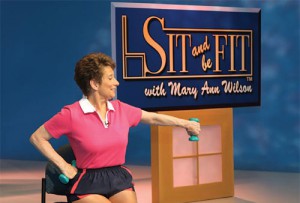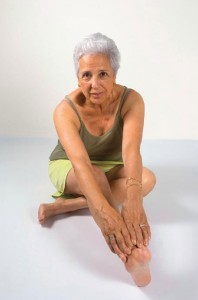February 25, 2011
By Michelle Porter Tiernan
Regular physical activity can keep you strong, improve your flexibility and help you manage stress. But when you’re a caregiver for a loved one with Alzheimer’s disease, it’s often difficult to find time to exercise.

If you don’t exercise, however, you stand to lose strength, mobility and balance as you age, according to the American Council on Exercise. Inactivity can have serious health consequences and makes it more difficult to achieve simple tasks, like carrying groceries or putting away dishes.
“[A lack of] time should not be an excuse for not exercising,” says senior fitness instructor Mary Ann Wilson, RN. “While your focus is on the person you are caring for, it’s important to remember to take time, just for you, at least once during the day.”
Sit and Be Fit
Wilson is the creator and host of the television series Sit and Be Fit, a 30-minute exercise program for older adults and caregivers. The series is broadcast on PBS stations throughout the U.S. and Canada. A seated workout can help lubricate and keep joints flexible, increase circulation and strengthen muscles for better posture.
Try these seated exercises at home:
- Deep breathing exercise. While inhaling deeply through your nose, pull your elbows backwards. Hold your breath, with your back just slightly arched, for a count of five. Force the air out through your mouth by gently contracting your abdominal muscles. Repeat up to 10 times.
- Spine stabilizer. Reach up to the ceiling with your right arm. Then reach down to the floor with your left arm. Repeat exercise with left arm up and right arm down. Look at your hands as you reach up and down.
- Abdominal Strengthener. Take a deep breath in. Breathe out, press your back into the chair and tighten your abdominal muscles. (Picture a string being pulled from your belly button to the back of the chair.) As you do this, avoid rounding your spine. Pull the abdominal muscles in.
Walk to Stay Sharp
Walking can help you stay mentally sharp as you age, according to the Fisher Center for Alzheimer’s Research Foundation. A four-year study of 750 older men and women living in Italy found that seniors who regularly took walks and participated in other forms of moderate exercise had a lower risk of developing a type of memory loss associated with poor blood flow in the brain. “If it all possible, take the person in your care out for a walk,” recommends Wilson. “The fresh air and change of scenery will brighten your day, and the additional exercise will energize both of you.”
Follow these tips to build more walking into your day:
- Park farther away. When you’re out running errands, park farther away from your destination than you normally would.
- Walk to nearby locations. Don’t drive—take a stroll instead.
- Take the stairs. Avoid taking the elevator or escalator and climb the stairs instead.
- Walk while you talk. If you have a portable phone, walk around the house or pace back and forth while talking.
- Take a commercial break. When watching television, get up and walk around the room during commercials. During a single one-hour show, you can get in more than 10 minutes of walking time.
- March in place. Lift those knees and walk in place while you’re doing dishes or folding laundry.

Move to Improve
The American Council on Exercise recommends functional fitness as a way for older adults to stay active and independent. Functional exercise only takes five minutes or less, requires no special equipment and can be done just about anywhere.
Try these functional fitness exercises throughout the day:
- Penny Pick-Up. Start three steps away from a penny placed on the floor. Slowly walk toward the penny. Stop to lunge or squat down to pick the penny up. Stand back up and continue walking another three steps. Repeat five times.
- Step Overs. Place a 6-inch-tall vegetable can on the floor and stand about 6 inches behind it with both feet facing forward. Slowly lift your right leg and—while maintaining your balance—step over the can. Shift your weight to balance on your front leg and lift your left leg up and over. Return to the starting position by stepping back over the can. Repeat 10 times.
- Standing Push-presses. Stand with your feet hip-width apart. Hold weights (2- to 10-pound dumbbells, or cans of vegetables) at shoulder height, palms facing forward with your weight on your heels. Slightly dip your knees to start the exercise, then straighten your knees and simultaneously push the weights overhead until your arms are fully extended. Avoid arching your lower back. Also, avoid leaning your head and neck forward. Slowly return your arms to shoulder level and repeat. Continue exercise for 30 seconds.
Short Bursts are Best
Short bursts of exercise can raise your heart rate and keep you stronger and more flexible. Wilson recommends exercising a few minutes at a time throughout the day. “Here is one easy way to remember— do some of the exercises before breakfast, lunch and dinner,” she says. “This way, it will become a habit.”
To learn more about Sit and Be Fit, call (509) 448-9438, visit www.sitandbefit.org, or e-mail sitandbefit@sitandbefit.org.
Sit and Be Fit Works Wonders
“I have appreciated your senior exercise program, Sit and Be Fit, for six years. I have worked in nursing homes for 12 years and part of my job is to exercise the residents. The diversity in your exercises helps keep the daily routine of exercising fun. Your exercises help so much to maintain a quality program for the residents working with stroke, amputation, arthritis, Parkinson’s, dementia of all levels, as well as age difference—40s to 101. The exercises are so excellent. Thanks for being so dedicated to seniors. Exercising helps immeasurably improve the quality of their lives.” -Janice Roberts, Activity Director – Encanto Palms Assisted Living, Phoenix, AZ
Source: www.ALZinfo.org. Author: Michelle Porter Tiernan, Preserving Your Memory: The Magazine of Health and Hope; Fall 2009.











